Mrz00m
Fractal Lover
 
Posts: 204
|
 |
« Reply #90 on: December 13, 2014, 03:14:37 PM » |
|
Oh gosh that's absolutely bufurcitabulous.
I set up an sound oscillation circuit in the computer which made those fractals once, except my HDD from that year was hit by a fractal light from the sky which had a branch pattern and a high voltage, so i don't think i have kept the circuit for the fractal oscillator, anyways it was too chaotic for tonal sound. the sound of the lightning that hit the house was similar to when a car hits the wall of the room you are standing in, and then everything was fine for a couple of days and then my power supply started smoking.
i did find a piccy of it in one of the less excited modes,
it went from this kind of waveform as in picture, to exacltly the same waveform as in the giant pictures, through various destabilisation phases. The digital setup was on program called Reaktor and it was an oscillator going through a peakEQ filter that boosed the signal and sent it back into the oscillator frequency.
it was mostly a stable oscillator, unitil the filter sent back frequencies that made the oscillator totally go crazy.
|
|
|
« Last Edit: December 13, 2014, 03:26:43 PM by Mrz00m »
|
 Logged
Logged
|
|
|
|
bkercso
Fractal Lover
 
Posts: 220
|
 |
« Reply #91 on: June 09, 2015, 04:17:02 PM » |
|
This is the bifurcation map of a dripping tap (dripping faucet) model published by Thomas Schmidt and Marko Marhl in 1997 ("A simple mathematical model of a dripping tap", http://fy.chalmers.se/~f7xiz/TIF081C/drippingfaucet.pdf). x-axis: water afflux (1E-7..1E-4) (linear scaling) y-axis: speed of drops (0..1) Simulation used Runge-Kutta numerical method with semi-adaptive stepsize: dt was 2E-5, and when dropped undo last step and switched to dt=dt/100. Did this 3 times at every drop, so I got million times precision around droppings. Picture made from 20,000 drops/column, calculation time was 15 hours on 2,5 GHz processor core. Img #28 Dripping faucet: velocity vs. afflux (whole map) 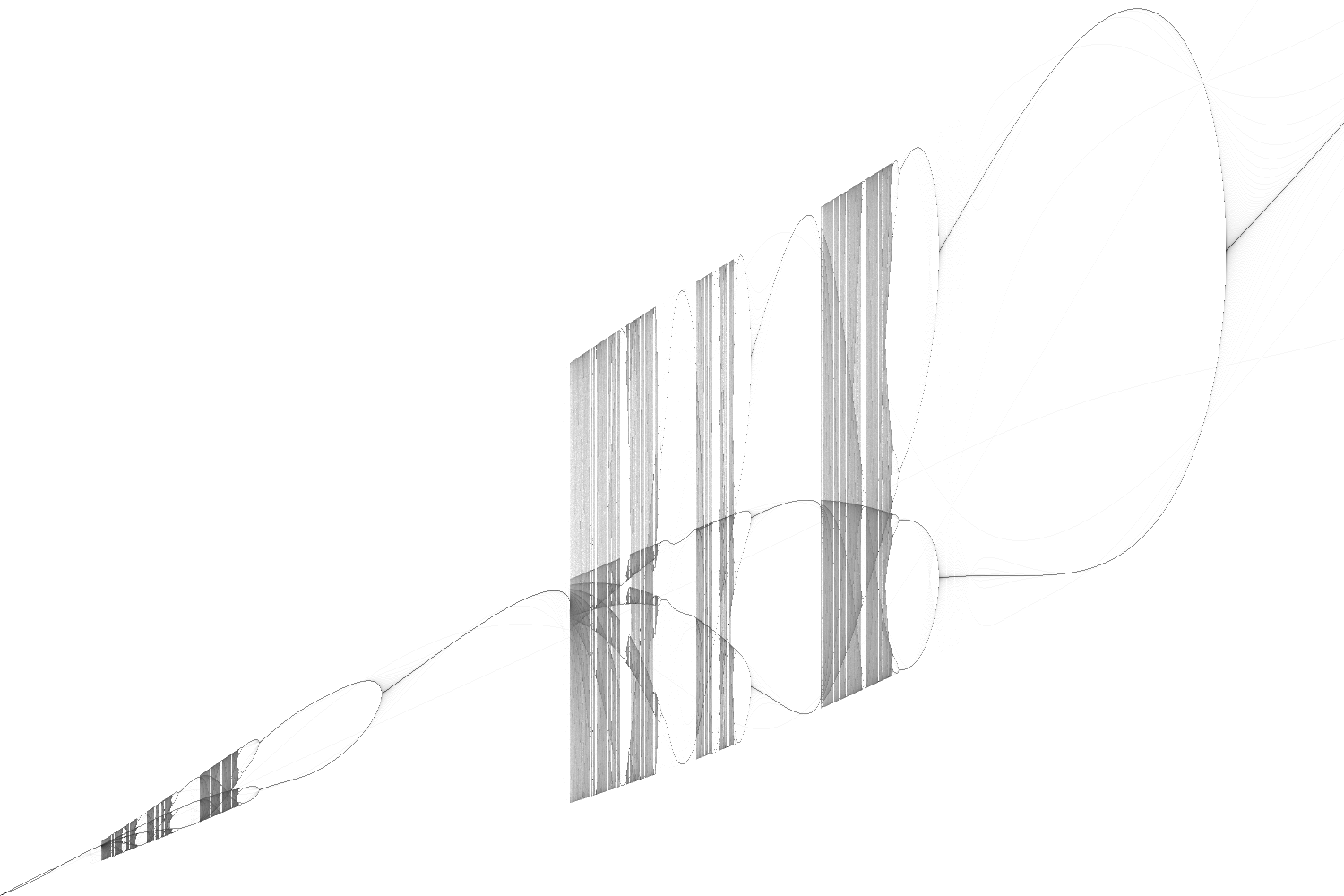 |
|
|
|
« Last Edit: June 12, 2015, 10:31:34 PM by bkercso »
|
 Logged
Logged
|
|
|
|
|
Chillheimer
|
 |
« Reply #92 on: June 09, 2015, 09:49:37 PM » |
|
wow, another thread I hadn't noticed before.. incredible pictures bkercso! I didn't know there is so much variation in simple bifurcation.. fascinating!
please keep em coming!
|
|
|
|
|
 Logged
Logged
|
--- Fractals - add some Chaos to your life and put the world in order. ---
|
|
|
bkercso
Fractal Lover
 
Posts: 220
|
 |
« Reply #93 on: June 10, 2015, 10:53:38 AM » |
|
Thanks, Chillheimer! I feel strong interest in structure of chaotic phisical systems, so I plan play a little with dripping tap and a bouncing ball on double slope model in the future...  |
|
|
|
|
 Logged
Logged
|
|
|
|
bkercso
Fractal Lover
 
Posts: 220
|
 |
« Reply #94 on: June 12, 2015, 10:38:52 PM » |
|
Long way to eternity  (Zoom of Img #28.) x-axis: water afflux, 4.2E-5..4.47E-5 y-axis: velocity of drops (~0.2..0.5) Average 50 points/pixel, dt=2E-5, calculation time was 53 hours, log. coloring. Img #29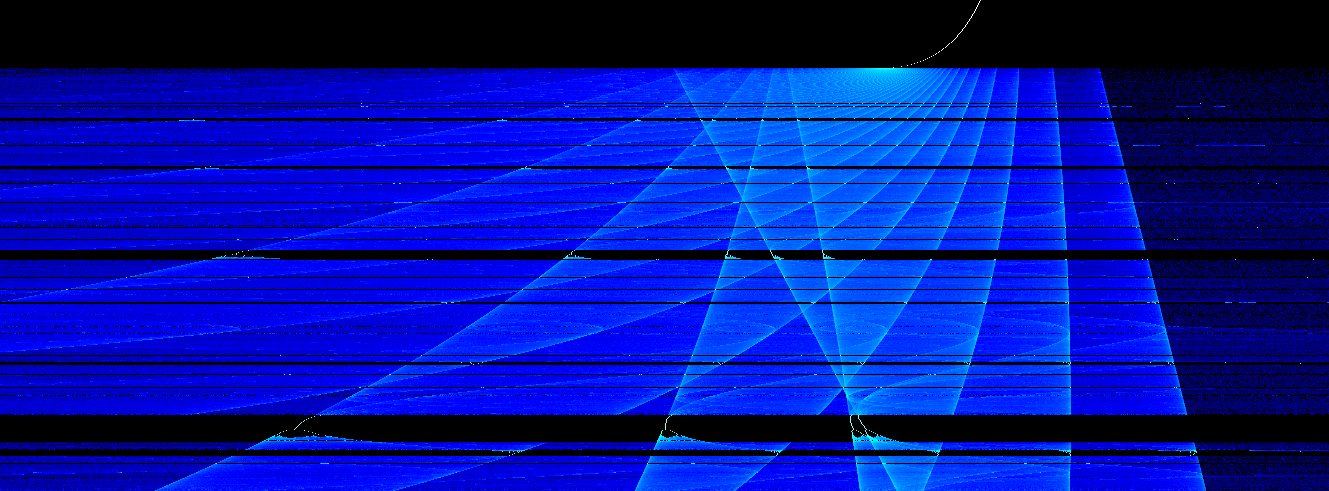 |
|
|
|
|
 Logged
Logged
|
|
|
|
bkercso
Fractal Lover
 
Posts: 220
|
 |
« Reply #95 on: June 14, 2015, 11:31:48 PM » |
|
|
|
|
|
|
 Logged
Logged
|
|
|
|
bkercso
Fractal Lover
 
Posts: 220
|
 |
« Reply #96 on: June 15, 2015, 11:44:44 AM » |
|
I rendered a zoom of dripping tap's bifurcations. x-axis: water afflux (4.43E-5..4.95E-5) (log scaling) y-axis: time between drops (0.2..0.7) Calculation time: 70 hours @2.5 GHz Log coloring, average 10 points/pixel Img #30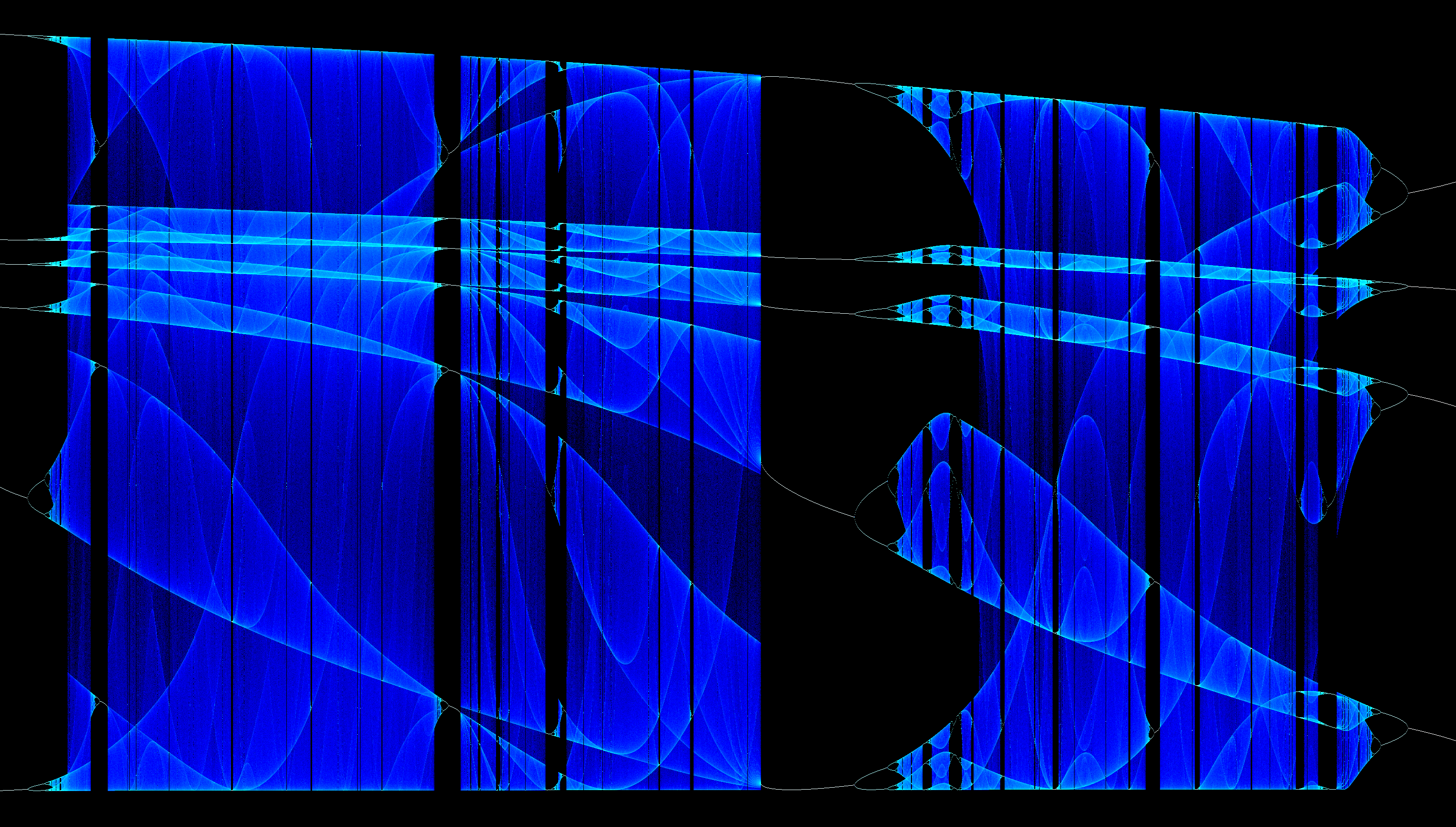 |
|
|
|
« Last Edit: June 15, 2015, 07:23:41 PM by bkercso »
|
 Logged
Logged
|
|
|
|
|
Softology
|
 |
« Reply #97 on: June 25, 2015, 06:23:55 AM » |
|
I tired the nebula rendering on these (same method as in the buddhabrot nebulabrot renderings). It doesn't help bring out any more details. Here are some tests... Logistic Map  Henon Attractor 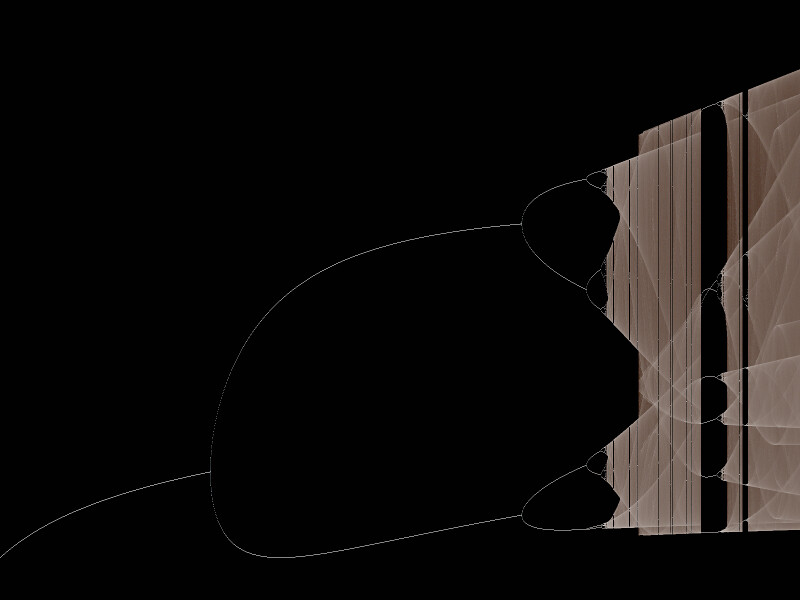 Delayed Logistic Map 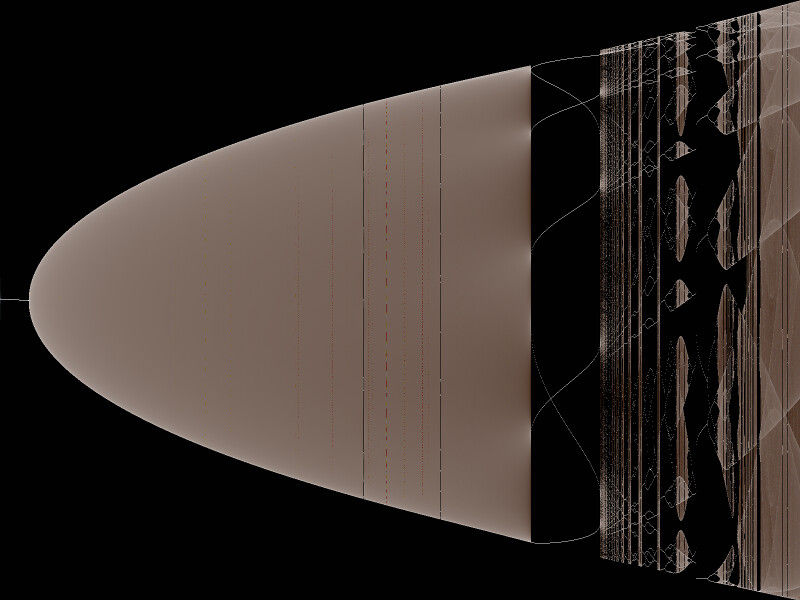 It seems like as you plot the Y axis pixels for each iteration loop they cover a random spread and do not concentrate in areas for low iterations vs higher iterations so you end up with an even almost grayscale soup. Using other shaded color palettes to map the iteration hit counts of pixels can help to tease out more details depending on the formula and palette. These are some quick test render results from the latest version of Visions Of Chaos http://softology.com.au/voc.htmLogistic Map 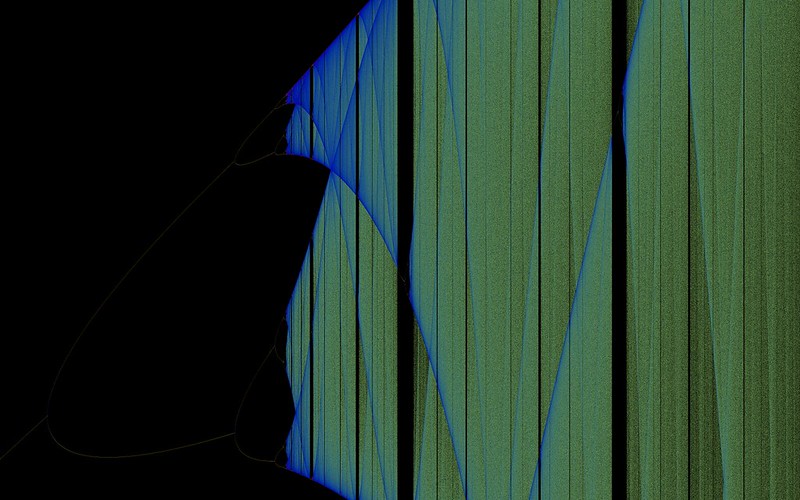 Henon Attractor  Delayed Logistic 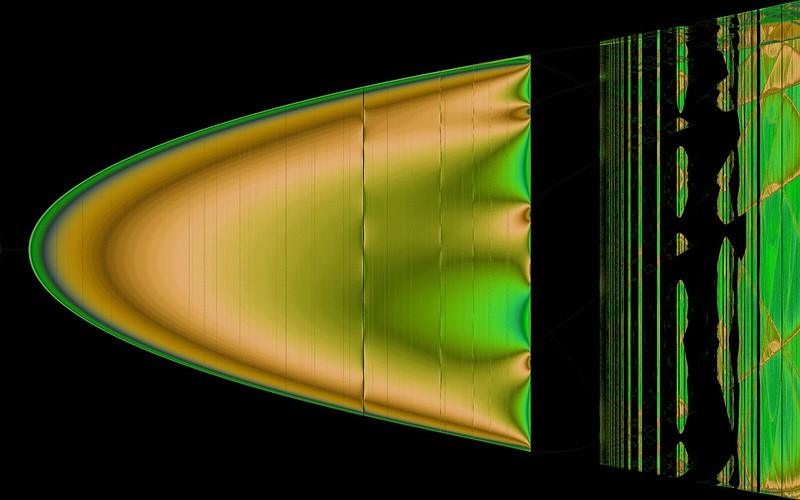 Bouncing Ball 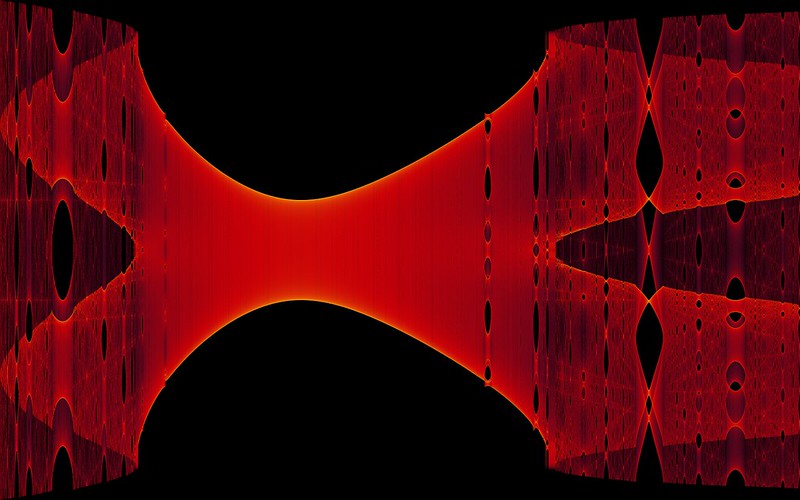 Jason. |
|
|
|
|
 Logged
Logged
|
|
|
|
|
Softology
|
 |
« Reply #98 on: June 25, 2015, 06:43:17 AM » |
|
This is the bifurcation map of a dripping tap (dripping faucet) model published by Thomas Schmidt and Marko Marhl in 1997 ("A simple mathematical model of a dripping tap", http://fy.chalmers.se/~f7xiz/TIF081C/drippingfaucet.pdf). x-axis: water afflux (1E-7..1E-4) (linear scaling) y-axis: speed of drops (0..1) Simulation used Runge-Kutta numerical method with semi-adaptive stepsize: dt was 2E-5, and when dropped undo last step and switched to dt=dt/100. Did this 3 times at every drop, so I got million times precision around droppings. Could you share the code for the iteration loop? I would love to experiment with it. Your image is so much more detailed that the included sample diagram in the paper you linked to. You should email the authors and give them a look at your results. Jason. |
|
|
|
|
 Logged
Logged
|
|
|
|
bkercso
Fractal Lover
 
Posts: 220
|
 |
« Reply #99 on: June 25, 2015, 09:59:04 AM » |
|
Shure, of course! I did not integrated it into my big program, but I share it now. Periodicity test accelerates it, but I think adaptive stepsize would not, because water afflux is constant, so system is always changing with almost the same velocity. For further info please see the first linked article. Parameter- and value range (v and t devided by picturesize): water afflux: 1E-6..1E-4
v: 0..1
t: 0.1..0.6
picturesize: 0.0003 for v, 0.003 for tInitial values: dt_=2E-5; { 1E-5..1E-3 }
Dr_=1E-2; { spring constant }
beta1=3E-4;
beta2=1E-1;
alpha=2.86E-2;
l_initial=2E-2;
lmax=3E-2;
m_initial=1E-6;
v_initial=0;
g=9.81;The iterated code (use 4rd order Rungke-Kutta method): if l<lmax then dripped:=false;
beta:=beta1+beta2*afflux;
dm:=afflux*dt;
m_0:=m; l_0:=l; v_0:=v;
{m:=m+dm; { Euler-method, don not use }
{l:=l+v*dt;
v:=v+(g-(Dr*l+beta*v)/m)*dt;}
ar:=(Dr_*l+beta*v)/m; { RK4 1. step }
k1_m:=dm;
m_i:=m+k1_m/2;
k1_l:=v*dt;
l_i:=l+k1_l/2;
k1_v:=(g-ar)*dt;
v_i:=v+k1_v/2;
ar_i:=(Dr_*l_i+beta*v_i)/m_i; { RK4 2. step }
k2_m:=dm;
{m_i:=m+k2_m/2;} { do not change now }
k2_l:=v_i*dt;
l_i:=l+k2_l/2;
k2_v:=(g-ar_i)*dt;
v_i:=v+k2_v/2;
ar_i:=(Dr_*l_i+beta*v_i)/m_i; { RK4 3. step }
k3_m:=dm;
m_i:=m+k3_m;
k3_l:=v_i*dt;
l_i:=l+k3_l;
k3_v:=(g-ar_i)*dt;
v_i:=v+k3_v;
ar_i:=(Dr_*l_i+beta*v_i)/m_i; { RK4 4. step }
k4_m:=dm;
{m:=m+(k1_m+2*(k2_m+k3_m)+k4_m)/6;} { faster if: }
m:=m+dm;
k4_l:=v_i*dt;
l:=l+(k1_l+2*(k2_l+k3_l)+k4_l)/6;
k4_v:=(g-ar_i)*dt;
v:=v+(k1_v+2*(k2_v+k3_v)+k4_v)/6; When l>lmax I undo last step and continue with dt=dt/10. Do this 6 times. dt:=dt/10; undo:=undo+1; m:=m_0; l:=l_0; v:=v_0; After when l>lmax again, dripping: if quantity='v' then d[i]:=v else d[i]:=t;
d[i]:=d[i]/picturesize; { normalizing }
if d[i]<min then min:=d[i];
if d[i]>max then max:=d[i];
m:=m*alpha/(alpha+v);
v:=0;
l:=lmax;
dripped:=true;
dt:=dt_;
undo:=0; Emailing to authors is a good idea, but dripping faucet is one of the most discussed chaotic system. An other author pair (Ken Kiyono and Nobuko Fuchikami) publicated about this system approx. over 10 years. It is worth read theirs results: http://arxiv.org/pdf/chao-dyn/9904012.pdf |
|
|
|
« Last Edit: June 30, 2015, 11:06:43 AM by bkercso »
|
 Logged
Logged
|
|
|
|
bkercso
Fractal Lover
 
Posts: 220
|
 |
« Reply #100 on: June 25, 2015, 10:10:52 AM » |
|
Your last pic about bouncing ball with this linear coloring and oversampling is really very detailed. Thx for it!
|
|
|
|
|
 Logged
Logged
|
|
|
|
bkercso
Fractal Lover
 
Posts: 220
|
 |
« Reply #101 on: June 26, 2015, 09:13:16 AM » |
|
I recalculated Img #30 with average 35 points/pixel, it took 9 days. Virtual physical dripping time was approx. 1 year. Img #31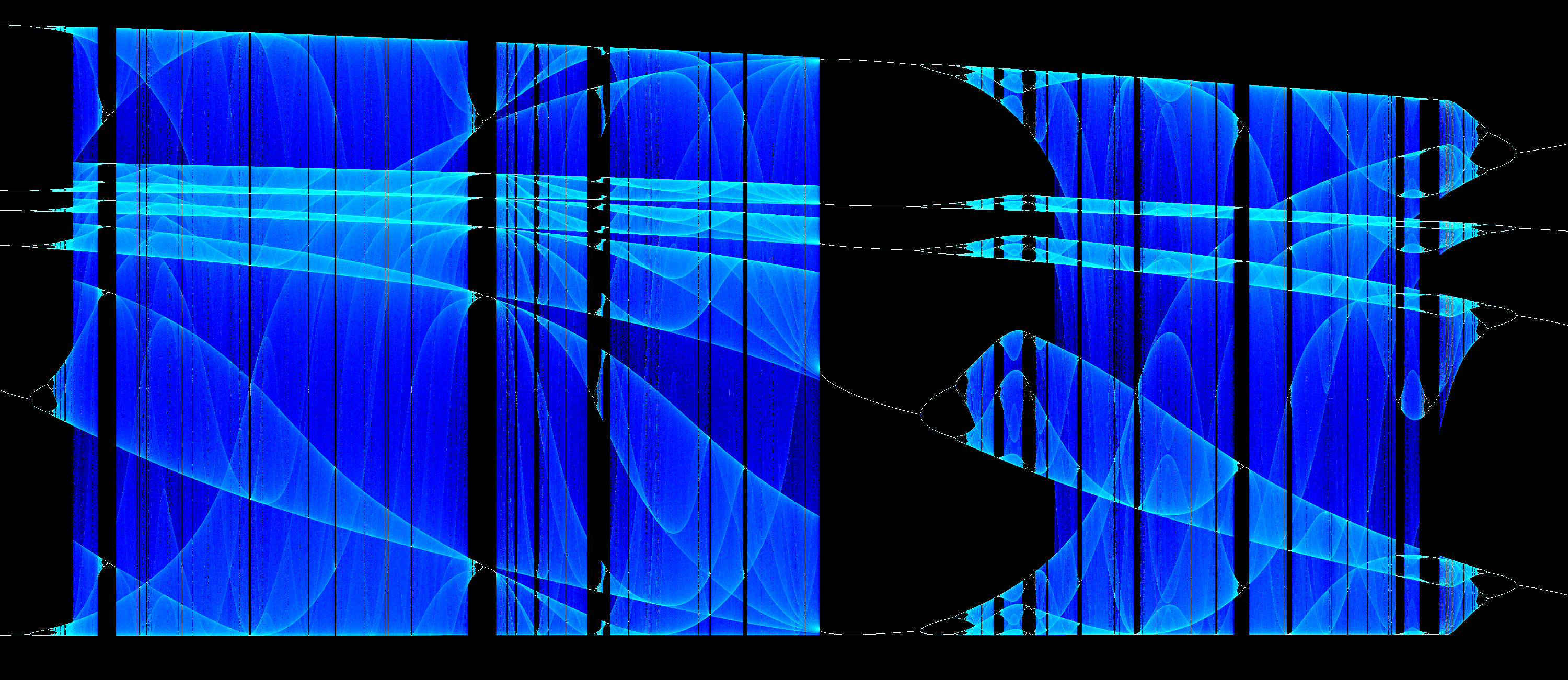 |
|
|
|
« Last Edit: June 27, 2015, 10:36:06 PM by bkercso »
|
 Logged
Logged
|
|
|
|
|
|
bkercso
Fractal Lover
 
Posts: 220
|
 |
« Reply #103 on: June 30, 2015, 11:08:02 AM » |
|
Oops, I missed an important row from the code of dripping tap!  beta:=beta1+beta2*afflux; I also updated the code above. |
|
|
|
|
 Logged
Logged
|
|
|
|
DarkBeam
Global Moderator
Fractal Senior
     
Posts: 2512
Fragments of the fractal -like the tip of it
|
 |
« Reply #104 on: June 30, 2015, 12:32:20 PM » |
|
Lol for the high voltage fractal.  You were lucky to survive.... cheers  |
|
|
|
|
 Logged
Logged
|
No sweat, guardian of wisdom!
|
|
|
|


















